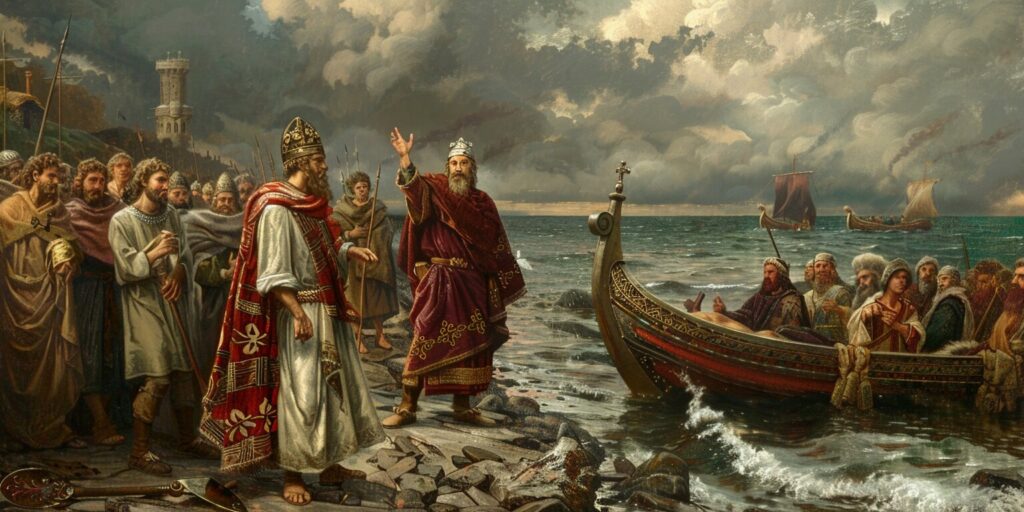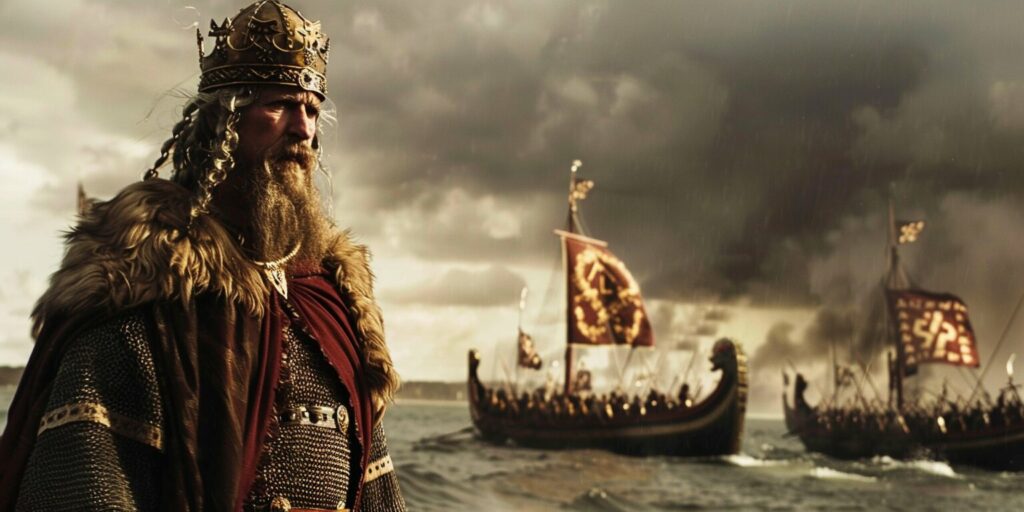Introduction
Welcome to our article on Canute, also known as Canute the Great, the Viking conqueror who became the King of England in the 11th century. Canute’s reign marked a significant period of political and cultural change in England, as well as in Denmark and Norway, which were also under his rule.
Canute’s claim to power began with his path to the throne as the son of Sweyn Forkbeard, the King of Denmark and Norway. His father’s influence played a crucial role in shaping Canute’s ambitions to expand his territories and become a ruler in his own right.
In 1013, Canute successfully invaded England and became the Danish King of England. However, his rule faced opposition from Edmund Ironside, the Anglo-Saxon King of England, leading to a battle for supremacy between the two rulers.
Under Canute’s rule, the kingdoms of England, Denmark, and Norway experienced a new era of governance. As the King of England, Canute aimed to consolidate his power and bring stability to the kingdom. He implemented policies that fostered cultural exchanges and cooperation between Denmark and England, strengthening the Nordic connection.
Canute’s reign extended beyond England and Denmark. He also expanded his territories into Norway, becoming the King of Norway. His marriage to Emma of Normandy, the widow of Ethelred II (the previous Anglo-Saxon King of England), helped him gain legitimacy and consolidate his rule.
As an effective ruler, Canute’s governance and policies aimed to unite the realms he ruled. He faced challenges in ruling diverse populations and navigating complex political alliances, but he proved himself as a true leader through his strategic acumen and ability to maintain law and order across his territories.
Canute’s reign left a lasting impact on the political and cultural landscape of the regions he ruled. His conquests and policies shaped the future of Denmark, England, and Norway, and he is remembered as a conqueror who successfully expanded his empire and brought stability to the North Sea region.
Join us as we explore Canute’s fascinating journey as a Viking conqueror turned King of England, Denmark, and Norway and uncover the lasting legacy he left behind.
Canute’s Claim to Power
Canute, also known as Canute the Great, had a remarkable journey to becoming one of the most influential rulers of his time, markedly after Canute returned to claim his throne. Born as the son of Sweyn Forkbeard, the King of Denmark and Norway, Canute’s path to the throne was paved by his father’s influential legacy.
Following the death of King Sweyn Forkbeard, Canute inherited the Danish crown and ascended to the throne, becoming the King of Denmark in 1016. This marked the beginning of his reign and his aspirations to expand his territories and influence.
However, Canute’s ambitions reached beyond the boundaries of Denmark. His most significant achievement was his successful invasion of England in 1013. As the Danish King of England, Canute challenged the rule of Edmund Ironside, the Anglo-Saxon King of England, leading to a fierce battle for supremacy between the two rulers.
To grasp the significance of Canute’s claim to power, it is vital to delve into the circumstances that led to his rise and the events that unfolded during his attempts to establish his dominion. Understanding Canute’s claim to power is key to comprehending the complexities of his reign and the lasting impact he had on England and the North Sea region as a whole.
Son of Sweyn: The Path to the Throne
Canute’s journey to becoming a king began with his illustrious lineage. As the son of Sweyn Forkbeard, Canute inherited his father’s aspirations and ambitions. Sweyn’s position as the King of Denmark and Norway laid a solid foundation for Canute’s ascendancy to power. Sweyn’s accomplishments and influence served as a catalyst for Canute’s claim to the throne and his subsequent conquests, particularly his assertion of power after King Sweyn Forkbeard’s death.
King of Denmark: Canute’s Reign Begins
After Sweyn’s passing, Canute assumed the mantle of the Danish crown, officially becoming the King of Denmark. This marked the beginning of his reign and his quest to strengthen his rule over the North Sea region. Canute’s reign as King of Denmark set the stage for his subsequent endeavors, showcasing his aptitude for leadership and his unwavering determination to expand his influence beyond Danish borders, underlined by his conquests in Wessex and Northumbria.

Conquest of England: The Battle for Supremacy
Canute’s most renowned feat was the successful invasion of England in 1013. As the Danish King of England, he challenged the rule of Edmund Ironside, the Anglo-Saxon King of England at the time. The battle for supremacy between Canute and King Ethelred unfolded in a complex series of events, each determined to establish their dominion over England in 1016.
The conquest of England was pivotal in Canute’s claim to power, solidifying his reputation as a skilled conqueror and a force to be reckoned with. This triumph shaped the trajectory of his future reign and cemented his place in history as Canute the Great, the Danish King of England.
The Kingdoms Under Canute
King of England: A New Era of Rule
As the King of England, Canute ushered in a new era of rule, combining Anglo-Saxon and Danish traditions. His reign marked a significant shift in the political landscape, as Canute aimed to consolidate his power and bring stability to the kingdom. Incorporating elements from both cultures, Canute fostered a sense of unity and cooperation among his subjects. By embracing and respecting England’s existing customs and laws, Canute gained the support and trust of the Anglo-Saxon population, establishing himself as a respected ruler.
Canute as King of Denmark: Strengthening the Nordic Connection
Canute’s reign as the King of Denmark further strengthened the connection between Denmark and England. He implemented policies that encouraged cultural exchanges and cooperation between the two realms, notably through strategic marriages and alliances with powerful earls. Canute recognized the shared heritage and language of the Norse people, and he actively promoted the preservation and celebration of their cultural identity. This established a strong bond between Denmark and England and created a sense of unity among the Nordic countries.
Expansion into Norway: Canute as King of Norway
Driven by his ambition for expansion, Canute extended his rule into Norway and became the King of Norway as well. This strategic move solidified his position as a powerful ruler in the North Sea region. Canute’s conquest of Norway further expanded his empire and allowed him to exert his influence over an even larger territory. With Norway under his control, Canute’s authority as a monarch reached new heights, cementing his status as one of the most influential rulers of his time.
Canute’s marriage to Emma of Normandy, the widow of Ethelred II, the previous Anglo-Saxon King of England, played a significant role in his consolidation of power. This union not only brought legitimacy to Canute’s rule but also helped him gain the support of the Anglo-Saxon nobility. By marrying into the royal family, Canute effectively merged the Danish and Anglo-Saxon lineages, further solidifying his claim to the throne and establishing himself as a true king in the eyes of his subjects.
Canute’s Governance and Policies
Uniting the Realms: Strategies and Challenges
Canute’s reign as king marked a period of conquest, consolidation, and governance. As a ruler, Canute was determined to unite the realms he ruled, including England and Denmark. To achieve this ambitious goal, he implemented various strategies and faced several challenges along the way.
One of the key challenges Canute faced was ruling diverse populations with different languages, cultures, and traditions. To address this, Canute implemented a combination of Danish and Anglo-Saxon systems of governance. This allowed him to incorporate aspects of both cultures into his rule, fostering a sense of unity among his subjects, especially between the peoples of Wessex and Northumbria.
Canute recognized the importance of maintaining law and order across his territories, employing the support of local earls to enforce his policies. He established a strong central authority, ensuring that his subjects felt secure and protected. By enforcing laws and resolving disputes, Canute maintained stability and promoted a peaceful coexistence among the various factions within his kingdom.
However, Canute’s leadership was not without its challenges. He faced resistance from those who doubted his ability to rule effectively, particularly in England, where he had to prove his worth as the successor to the Viking king. Canute’s actions and policies ultimately proved these skeptics wrong, as he successfully consolidated his power and established himself as a true king.
The Legacy of Canute in England and Beyond
Canute’s governance and policies left a lasting impact on England and the regions under his rule. His efforts to promote Christianity, support education and culture, and strengthen trade relations contributed to the growth and development of his kingdom.
As a devout Christian, Canute actively promoted the spread of Christianity throughout his lands, a movement significantly supported after 1016. He commissioned the construction of churches and monasteries, supporting the Christian clergy and encouraging the conversion of his subjects. This religious fervor played a significant role in shaping the cultural landscape of his kingdom and fostering a sense of unity among his diverse subjects.

Canute also recognized the importance of education and intellectual pursuits. Under his rule, schools and universities were established, providing opportunities for learning and knowledge dissemination. This emphasis on education laid the foundation for future science, literature, and philosophy advancements.
Through his expansionist policies, Canute strengthened trade relations within his kingdom and with neighboring lands. He encouraged commerce and established fair and just trading practices, which led to economic prosperity and increased wealth for his subjects.
Canute’s legacy extended far beyond his reign. His governance and policies continue to be remembered and celebrated for their impact on England and the regions under his control. Canute’s reign exemplifies the ability of an effective ruler to navigate challenges, build a unified kingdom, and leave a lasting mark on history.
The Lasting Impact of King Canute
Reflecting on Canute’s Reign: A Conqueror Remembered
Canute’s reign as the King of England, Denmark, and Norway left a lasting impact on the political and cultural landscape of the regions he ruled. His conquests and policies shaped the future of these countries and left behind a legacy that is still remembered today.
Reflecting on Canute’s reign, he is widely regarded as a conqueror who successfully expanded his empire and significantly brought stability to the North Sea region through strategic marriages and alliances with influential figures like Harold. His ability to rule diverse populations and navigate complex political alliances is seen as a testament to his leadership skills and strategic acumen.
One of the significant legacies of King Canute’s rule was the return of the Danish ruling class back to Denmark. After Canute’s successful invasion of England, many Danes settled in England as part of his administration and military forces. However, Canute’s policies and governance eventually led to the repatriation of these Danes, contributing to a rejuvenation of Danish culture and power in Denmark itself.
Another significant aspect of Canute’s reign was his marriage to Emma of Normandy, the widow of Ethelred II, the previous Anglo-Saxon King of England. This union solidified Canute’s claim to the English throne and brought him closer to the Holy Roman Emperor. Emma’s connections and influence played a crucial role in Canute’s reign and expanded his reach beyond the North Sea region.
Even today, the impact of Canute’s rule can be seen in the historical and cultural ties between Denmark, England, and Norway. His conquests and governance laid the foundation for future political developments and left a lasting imprint on the regions he ruled.
Summary
Canute, also known as Canute the Great was a Viking conqueror who became the King of England, Denmark, and Norway in the 11th century. His claim to power began with his path to the throne as the son of Sweyn Forkbeard and his subsequent reign as the King of Denmark. Canute’s conquest of England in 1016 was a significant milestone in his journey to establish a North Sea empire.
Under Canute’s rule, the kingdoms of England, Denmark, and Norway experienced a new era of governance and cultural exchange. His policies aimed to unite these realms and address the challenges of ruling diverse populations, including fostering relations between Wessex and Northumbria. Canute’s lasting impact can be seen in his legacy, including his efforts to promote Christianity, support education and culture, and strengthen trade relations.
Canute’s reign is remembered as that of a conqueror who successfully navigated complex political alliances and left a lasting mark on the North Sea region. His ability to rule diverse populations and govern effectively solidified his position as a true king. Despite his initial forceful ascension to power, Canute proved himself as an astute and capable ruler, earning the respect and admiration of his subjects.

